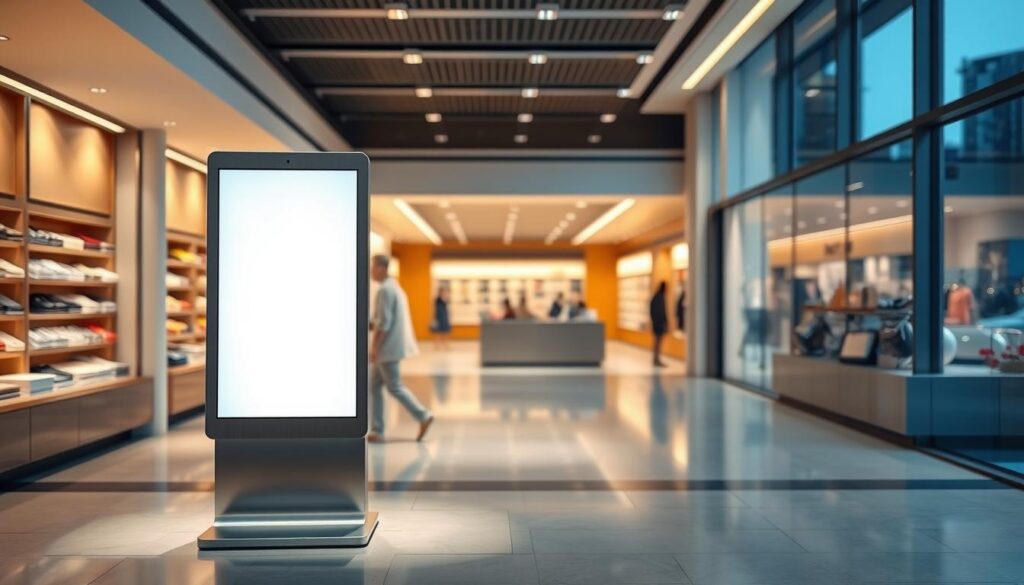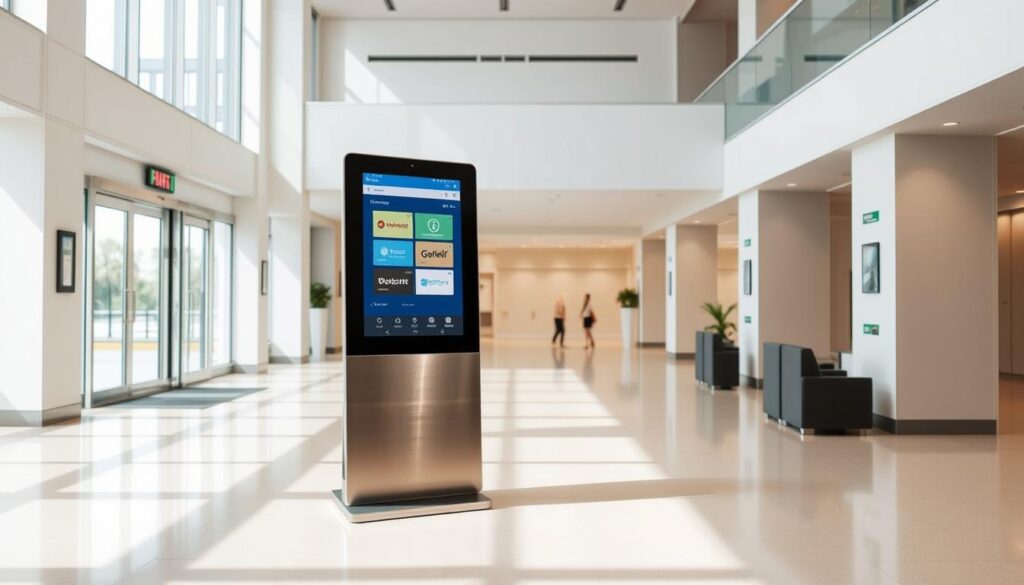Digital Display Touch Screen Kiosk: Enhancing Customer Experience
Summary
Interactive kiosk technology is changing how businesses meet customers. Digital display touch screen kiosks offer easy-to-use interfaces and real-time data. This creates personalized shopping experiences. Such efforts lead to 80% of shoppers preferring personalized experiences and 20% higher sales. Modern […]
Interactive kiosk technology is changing how businesses meet customers. Digital display touch screen kiosks offer easy-to-use interfaces and real-time data. This creates personalized shopping experiences. Such efforts lead to 80% of shoppers preferring personalized experiences and 20% higher sales.

Modern touchscreen kiosks work like 24/7 service agents. They use cameras and scanners for tailored interactions. Modular screens fit any environment. Over 63% of consumers find digital signage very engaging, and 47% notice brands more.
Retailers see a 29% increase in purchases with interactive kiosks. These systems also help refine marketing strategies. MetroClick’s case studies show customized kiosks boost engagement and streamline operations.
From healthcare check-ins to mall wayfinding, digital display touch screen kiosk tech connects physical and digital spaces. This ensures businesses stay ahead in the experience-driven economy.
Understanding Interactive Kiosk Technology
Interactive kiosk technology has changed a lot over the years. Now, touchscreen kiosk systems use advanced capacitive multi-touch interfaces. This makes them precise and durable. It also lets businesses create experiences that meet user needs.
Key Components of Modern Digital Kiosks
Today’s digital signage kiosk systems are a mix of hardware and software. They offer smooth interactions. Key features include:
- Hardware: 43″ 4K displays, 1080p screens for smaller models, and 5MP webcams for secure transactions.
- Software: Visitor management systems, content management platforms, and Windows 11 Pro for security and updates.
- Connectivity: WiFi/Ethernet for real-time data transfer and cloud integration.
How Touch Interfaces Drive Engagement
Touchscreen interfaces make technology easy for everyone. For example, MedStar Union Memorial Hospital uses touchscreen kiosks to speed up patient check-ins. This cuts wait times by 30%.
Retailers also see benefits. Self-service options increase transaction speeds. A client saw a big jump to 97% card-based payments.
Technical Specifications Overview
| Screen Size | Resolution | Storage | Processing |
|---|---|---|---|
| 22″–43″ | 1080p (22″–32″) / 4K (43″ and up) | 120GB SSD (upgradable to 250GB) | Quad-Core CPU, 8GB RAM |
These specs ensure reliability in places like hospitals or big office spaces. For example, TouchSource kiosks work 24/7 in a 750,000 sq ft building with little downtime.
Benefits of Digital Display Touch Screen Kiosks for Businesses
Businesses that use digital display touch screen kiosks get ahead by working smarter and better with customers. These self-service kiosk systems make transactions fast, cutting wait times by half. They work all day, every day, so you don’t have to worry about staff during busy times.
For instance, the Pima Association of Governments moved to card payments completely. This made transactions smoother and cut down on mistakes.

- Cost Efficiency: Kiosks save money by doing routine tasks, so staff can focus on more important things.
- Scalability: You can easily change what’s shown on the kiosk, without having to redo your branding.
- Security: Kiosks use advanced security like EMV chip readers and biometric checks, making transactions safer than old methods.
Technical details are important too. Here’s a look at what standard and advanced kiosks offer:
| Feature | 22″ Model | 43″ Model |
|---|---|---|
| Resolution | 1080p (1920×1080) | 4K (3840×2160) |
| Storage | 120 GB SSD | 250 GB SSD |
| Webcam | Not included | 5-megapixel |
| Connectivity | Ethernet only | Ethernet + WiFi |
Kiosks also help gather data, which helps in making better marketing plans. They come with a 1-year warranty and secure mounts. This means businesses can rely on them to improve customer loyalty and cut down on work hassle. Whether it’s retail or healthcare, self-service kiosk tech brings real benefits through better efficiency and customer happiness.
Strategic Applications Across Industries
Touchscreen kiosks are changing how businesses work in retail, healthcare, transportation, and hospitality. They make workflows smoother and customer satisfaction higher. These systems offer specific solutions for different sectors.

70% of customers prefer self-service options, driving demand for intuitive digital solutions.
Here’s how industries are adopting these tools:
- Retail: digital retail kiosk systems let shoppers browse, compare, and buy without help. A big chain saw a 32% sales increase after adding kiosks in stores.
- Healthcare: information kiosk networks in hospitals cut patient wait times by 30%. They help visitors find clinics and show health resources.
- Transportation: Airports and train stations use kiosks for real-time flight updates and interactive maps. This reduces lines by 40%.
- Hospitality: Hotels use kiosks for self-check-in and guides to local attractions. This boosts guest convenience and staff efficiency.
These systems also save money by reducing printed materials and lowering operational costs. Businesses see ROI in 1–3 years. With 90% of customers liking stores with interactive tech, these systems are changing service delivery.
Essential Implementation Considerations for Touchscreen Kiosks
Setting up touchscreen digital kiosks needs careful planning. This ensures they work well, are easy to use, and follow the law. Businesses must think about technical, legal, and user needs to get the most value and avoid fines.
- Accessibility Compliance: ADA rules require enough space (30×48 inches) and features like voice guidance. They also ask for adjustable heights and high-contrast displays. Following these rules can make users 70% happier and help reach more people.
- Hardware & Software Choices: Choose strong screens (like 4K panels) and easy-to-use interfaces. Medical places must follow HIPAA to cut data breaches by 50%.
- Placement Strategies: Put kiosks in bright spots with clear signs. Hospitals and airports see 25% more use when kiosks are at eye level.
| Standard | Requirement | Benefit |
|---|---|---|
| ADA | Wheelchair access, voice prompts | 70% higher satisfaction among disabled users |
| EAA | EU-wide accessibility by 2025 | Avoids €20M+ fines under GDPR |
| HIPAA | Encrypted patient data | Reduces breach risks by 50% |
Security is key, with encryption and following GDPR/CCPA. Not following these can cost up to $50,000 per mistake. Regular checks can lower legal risks by 30%.
- Implement text-to-speech for vision-impaired users
- Use tactile controls for motor disabilities
- Test interfaces with diverse user groups
Keep kiosks up to date with firmware updates and listen to user feedback. Focusing on accessibility and following the law is key for lasting success and avoiding expensive legal issues.
Emerging Trends in Digital Signage Kiosk Technology
Modern digital signage kiosk solutions are changing fast. They’re driven by AI, IoT, and design that puts users first. These changes make industries like retail and healthcare better.
AI and Personalization Features
AI-powered self-service kiosk systems watch how users act in real time. For example, retail kiosks suggest products based on what you’ve looked at before. About 50% of businesses using AI kiosks say they’ve seen happier customers.
AR lets users see products in 3D. Facial recognition makes checking in at healthcare places easier.
Contactless Interaction Capabilities
Contactless tech is now common in digital signage kiosk use. Voice commands and gestures mean no touching, making things cleaner. Kiosks also have special coatings to fight germs.
Places like airports use gesture controls to help people stay apart. This helps follow social distancing rules.
Integration with Mobile and IoT Ecosystems
IoT lets self-service kiosk systems talk to smart devices. Retail kiosks can send personalized coupons to your phone. By 2024, IoT will help track inventory better.
Smart city kiosks, like those in London, show live transit info. This is thanks to sensors and IoT.
“AR and VR integration will make kiosks the new gateway to immersive customer journeys.” – Tech Insights Report, 2023
From healthcare to retail, these trends focus on easy, safe, and smart tech. As data and biometric security become key, businesses want kiosks that meet new customer needs for quick and clean service.
Conclusion: Maximizing ROI from Your Interactive Kiosk Investment
Interactive kiosk technology is changing how we interact with customers. Businesses must weigh the costs now against future benefits. A good kiosk can increase customer engagement by 30% and cut service times by 15%.
With the global market expected to grow 9.5% annually until 2030, investing now pays off later.
ROI depends on matching kiosks with specific goals. For example, kiosks in airports or malls help visitors find what they need. They focus on metrics like how many transactions happen and how happy customers are.
Choosing the right screen brightness and making sure they are accessible is key. This might cost more upfront, but it’s worth it for the long run. Outdoor kiosks need to be tough and have good cooling systems, but they save money on staff costs.
Analytics are the first step to making kiosks better. They help improve ads and make it easier for people to find their way. Keeping software up to date and working with trusted vendors is important to avoid problems.
Businesses that use advanced touchscreens or contactless payments stay ahead. As AI and touchless tech get better, kiosks will too. Companies need to budget for upkeep and security, like lockable cases.
With the right approach, kiosks can bring a 300% return on investment. They help keep brands competitive in a world that values self-service. By focusing on what customers need and using new technology, kiosks become valuable assets for both customer happiness and business success.